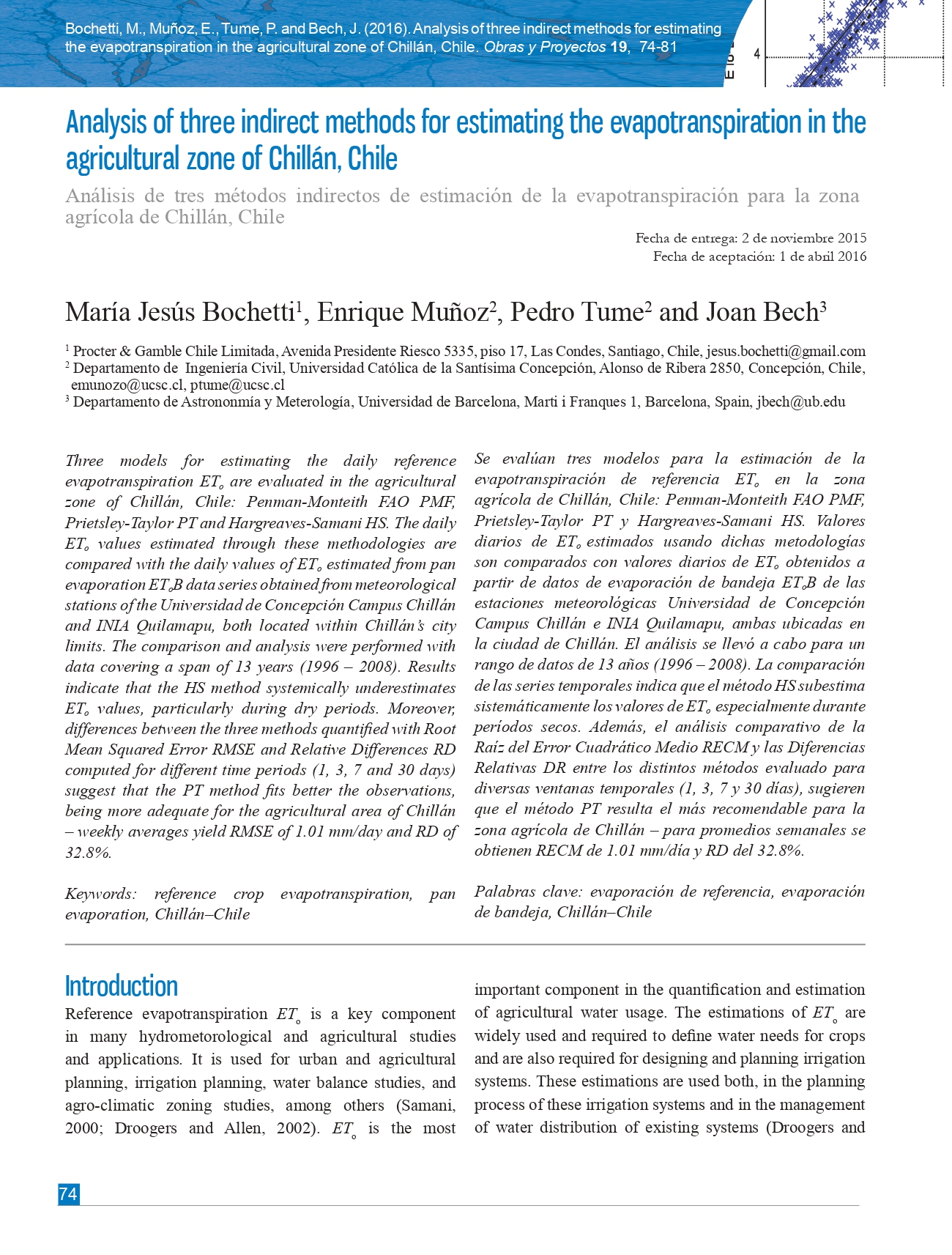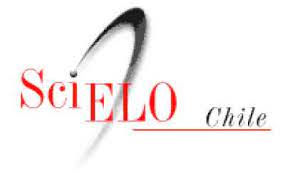Analysis of three indirect methods for estimating the evapotranspiration in the agricultural zone of Chillán, Chile
DOI:
https://doi.org/10.4067/S0718-28132016000100006Keywords:
reference crop evapotranspiration, pan evaporation, Chillán-ChileAbstract
Three models for estimating the daily reference evapotranspiration ETo are evaluated in the agricultural zone of Chillán, Chile: Penman-Monteith FAO PMF, Prietsley-Taylor PT and Hargreaves-Samani HS. The daily ETo values estimated through these methodologies are compared with the daily values of ETo estimated from pan evaporation ETB data series obtainedfrom meteorological stations of the Universidad de Concepción Campus Chillán and INIA Quilamapu, both located within Chillán ’s city limits. The comparison and analysis were performed with data covering a span of 13 years (1996 - 2008). Results indicate that the HS method systemically underestimates ETo values, particularly during dry periods. Moreover, differences between the three methods quantified with Root Mean Squared Error RMSE and Relative Differences RD computed for different time periods (1, 3, 7 and 30 days) suggest that the PT method fits better the observations, being more adequate for the agricultural area of Chillán - weekly averages yield RMSE of 1.01 mm/day and RD of 32.8%.
References
Allen, R., Pereira, L., Raes, D. and Smith, M. (1998). Crop evapotranspiration - Guidelines for computing crop water requirements. FAO Irrigation and Drainage paper 56, UN-FAO, Rome 300(9), D05109
Amatya, D.M., Skaggs, R.W., Gregory, JD. (1995). Comparison of methods for estimating REF-ET. Journal of Irrigation and Drainage Engineering 121(6), 427-435. https://doi.org/10.1061/(ASCE)0733-9437(1995)121:6(427)
Bowen, I.S. (1926). The ratio of heat losses by conduction and by evaporation from any water surface. Physical Review 27(6), 779-787. https://doi.org/10.1103/PhysRev.27.779
Byers, H.R. (1974). General Meteorology. 4th ed. McGraw Hill, New York
Droogers, P. and Allen, R. (2002). Estimating reference evapotranspiration under inaccurate data conditions. Irrigation and Drainage Systems 16(1), 33-45. https://doi.org/10.1023/A:1015508322413
George, B.A., Reddy, B.R.S., Raghuwanshi, N.S. and Wallender, W. (2002). Decision support system for estimating reference evapotranspiration. Journal of Irrigation and Drainage Engineering 128(1), 1-10. https://doi.org/10.1061/(ASCE)0733-9437(2002)128:1(1)
Hargreaves, G. and Allen, R. (2003). History and evaluation of Hargreaves evapotranspiration equation. Journal of Irrigation and Drainage Engineering 129(1), 53-63. https://doi.org/10.1061/(ASCE)0733-9437(2003)129:1(53)
Hube, G. (1989). El fenómeno de la evapotranspiración en la cuenca del Bío Bío. Master thesis, Universidad de Concepción
Jensen, M.E., Burman, R.D. and Allen, R.G. (1990). Evapotranspiration and irrigation water requirements. ASCE Manual 70:332-333
Kottek, M., Grieser, J., Beck, C., Rudolf, B. and Rubel, F. (2006). World map of the Koppen-Geiger climate classification updated. Meteorologische Zeitschrift 15(3), 259-263. https://doi.org/10.1127/0941-2948/2006/0130
Mercado, G. (2006). Estimación de la evapotranspiración de referencia utilizando información de temperatura del aire. Master thesis, Universidad de Concepción
Novoa, R., Villaseca, S., Del Canto, P., Rouanet, J., Sierra, C. y Del Pozo, A. (1989). Mapa Agroclimático de Chile. Instituto de Investigaciones Agropecuarias, Santiago, Chile
Priestley, C. and Taylor, R. (1972). On the assessment of surface heat flux and evaporation using large scale parameters. Monthly Weather Review 100(2), 81-92. https://doi.org/10.1175/1520-0493(1972)100%3C0081:OTAOSH%3E2.3.CO;2
Rana, G. and Katerji, N. (2000). Measurement and estimation of actual evapotranspiration in the field under Mediterranean climate: a review. European Journal of Agronomy 13(2), 125153. https://doi.org/10.1016/S1161-0301(00)00070-8
Salas, J.D., Delleur, J.W., Yevjevich, V and Lane W.L. (1980). Applied modeling of hydrological time series. Water Resources Publications, Michigan, USA
Samani, Z. (2000). Estimating solar radiation and evapotranspiration using minimum climatological data. Journal of Irrigation and Drainage Engineering 126(4), 265-267. https://doi.org/10.1061/(ASCE)0733-9437(2000)126:4(265)
Sánchez, J.M., Caselles, V and Scavone, G. (2008). Merging micro-meteorology and Landsat imagery to monitor daily evapotranspiration at a regional scale. Tethys 5, 37-46
Savage, M.J., Everson C.S. and Meterlerkamp, B.R. (2009). Bowen ratio evaporation measurement in a remote montane grassland: data integrity and fluxes. Journal of Hydrology 376(1), 249-260. https://doi.org/10.1016/j.jhydrol.2009.07.038
Sumner, D. and Jacobs, J. (2005). Utility of Penman-Monteith, Priestley-Taylor, reference evapotranspiration, and pan evaporation methods to estimate pasture evapotranspiration. Journal of Hydrology 308(1): 81-104. https://doi.org/10.1016/j.jhydrol.2004.10.023
Tabari, H. (2009). Evaluation of reference crop evapotranspiration equations in various climates. Water Resources Management 24(10), 2311-2337. https://doi.org/10.1007/s11269-009-9553-8
Tabari, H., Grismer, M.E. and Trajkovic, S. (2013). Comparative analysis of 31 reference evapotranspiration methods under humid conditions. Irrigation Science 31(2), 107-117. https://doi.org/10.1007/s00271-011-0295-z
Trajkovic, S. and Kolakovic, S. (2009). Evaluation of reference evapotranspiration equations under humid conditions. Water Resources Management 23(14), 3057-3067. https://doi.org/10.1007/s11269-009-9423-4
Wang, K. and Dickinson, R.E. (2012). A review of global terrestrial evapotranspiration: Observation, modeling, climatology, and climatic variability. Reviews of Geophysics 50(2): RG2005, 1-54. https://doi.org/10.1029/2011RG000373
Xiaoying, L. and Erda, L. (2005). Performance of the Piestley-Taylor equation in the semiarid climate of North China. Agricultural Water Management 71(1), 1-17. https://doi.org/10.1016/j.agwat.2004.07.007

Downloads
Published
Issue
Section
License
Copyright (c) 2016 Universidad Católica de la Santísima Concepción

This work is licensed under a Creative Commons Attribution-NonCommercial 4.0 International License.







